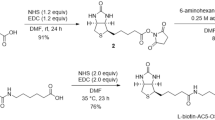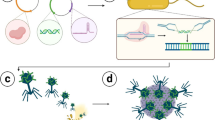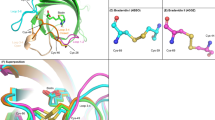Abstract
We have expressed a gene fusion of streptavidin and the two immunoglobulin G (IgG)–binding domains of protein A in Escherichia coli. The purified chimeric protein had full biotin–binding ability, and bound one IgG molecule per subunit (31.4 kD). The affinity of the chimeric protein both for biotin and IgG can be used to provide antibody molecules with additional recognition capabilities. For example, the chimera will allow any IgG molecule to be used for sensitive biotin–linked detection systems without the need for chemical modification.
This is a preview of subscription content, access via your institution
Access options
Subscribe to this journal
Receive 12 print issues and online access
$209.00 per year
only $17.42 per issue
Buy this article
- Purchase on Springer Link
- Instant access to full article PDF
Prices may be subject to local taxes which are calculated during checkout
Similar content being viewed by others
References
Sjöholm, I. 1975. Protein A from Staphylococcus aureus. Spectropolarimetric and spectrophotometric studies. Eur. J. Biochem. 51: 55–61.
Surolia, A., Pain, D. and Khan, M.I. 1982. Protein A: nature's universal anti-antibody. Trends Biochem. Sci. 7: 74–76.
Lindmark, R., Thorén-Tolling, K. and Sjöquist, J. 1983. Binding of immunoglobulins to protein A and immunoglobulin levels in mammalian sera. J. Immunol. Methods 62: 1–13.
Tai, M.-S., Mudgett-Hunter, M., Levinson, D., Wu, G.-M., Haber, E., Oppermann, H. and Huston, J.S. 1990. A bifunctional fusion protein containing Fc-binding fragment B of Staphylococcal protein A amino terminal to antidigoxin single-chain Fv. Biochemistry 30: 8024–8030.
Chaiet, L. and Wolf, F.J. 1964. The properties of streptavidin, a biotin-binding protein produced by Streptomycetes. Arch. Biochem. Biophys. 106: 1–5.
Chaiet, L., Miller, T.W., Tausing, F. and Wolf, F.J. 1963. Antibiotic MSD-235. II. Separation and purification of synergistic components. Antimicrob. Agents Chemother. 3: 28–32.
Green, N.M. 1990. Avidin and streptavidin. Methods Enzymol. 184: 51–67.
Green, N.M. 1975. Avidin. Adv. Prot. Chem. 29: 85–133.
Bayer, E.A. and Wilchek, M. 1980. The use of the avidin-biotin complex as a tool in molecular biology. Methods Biochem. Anal. 26: 1–46.
Fuccillo, D.A. 1985. Application of the avidin-biotin technique in microbiology. BioTechniques 3: 494–501.
Wilchek, M. and Bayer, E.A. 1988. The avidin-biotin complex in bioanalytical applications. Anal. Biochem. 171: 1–32.
Wilchek, M. and Bayer, E.A. 1990. Avidin-biotin technology. Methods Enzymol. 184: 5–13.
Sano, T. and Cantor, C.R. 1990. Expression of a cloned streptavidin gene in Escherichia coli. Proc. Natl. Acad. Sci. U.S.A. 87: 142–146.
Studier, F.W., Rosenberg, A.H., Dunn, J.J. and Dubendorff, J.W. 1990. Use of T7 RNA polymerase to direct expression of cloned genes. Methods Enzymol. 185: 60–89.
Sano, T. and Cantor, C.R. 1991. Expression vectors for streptavidin-containing chimeric proteins. Biochem. Biophys. Res. Com. 176: 571–577.
Ljungquist, C., Jannson, B., Moks, T. and Uhl´n, M. 1989. Thiol-directed immobilization of recombinant IgG-binding receptors. Eur. J. Biochem. 186: 557–561.
Björk, I., Petersson, B.-Å. and Sjöquist, J. 1972. Some physicochemical properties of protein A from Staphylococcus aureus. Eur. J. Biochem. 29: 579–584.
Campbell, J.L., Richardson, C.C. and Studier, F.W. 1978. Genetic recombination and complementation between bacteriophage T7 and cloned fragments of T7 DNA. Proc. Natl. Acad. Sci. U.S.A. 75: 2276–2280.
Sambrook, J., Fritsch, E.F. and Maniatis, T. 1989. Molecular Cloning: A Laboratory Manual, 2nd ed. Cold Spring Harbor Laboratory Press, Cold Spring Harbor, NY.
Studier, F.W. and Moffatt, B.A. 1986. Use of bacteriophage T7 RNA polymerase to direct selective high-level expression of cloned genes. J. Mol. Biol. 189: 113–130.
Löwenadler, B., Nilsson, B., Abrahms´n, L., Moks, T., Ljungqvist, L., Holmgren, E., Paleus, S., Josephson, S., Philipson, L. and Uhlén, M. 1986. Production of specific antibodies against protein A fusion proteins. EMBO J. 5: 2393–2398.
Uhlén, M., Guss, B., Nilsson, B., Gatenbeck, S., Philipson, L. and Lindberg, M. 1984. Complete sequence of the Staphylococcal gene encoding protein A. A gene evolved through multiple duplications. J. Biol. Chem. 259: 1695–1702.
Moks, T., Abrahmsén, L. Österlöf, B., Josephson, S., Östling, M., Enfors, S.-O., Persson, I., Nilsson, B. and Uhlén, M. 1987. Large-scale affinity purification of human insulin-like growth factor I from culture medium of Escherichia coli. Bio/Technology 5: 379–382.
Hofmann, K., Wood, S.W., Brinton, C.C., Montibeller, J.A. and Finn, F.M. 1980. Iminobiotin affinity columns and their application to retrieval of streptavidin. Proc. Natl. Acad. Sci. U.S.A. 77: 4666–4668.
Wei, R.-D. 1970. Assay of avidin. Methods Enzymol. 18A: 424–427.
Kyhe-Andersen, J. 1984. Electroblotting of multiple gels: a simple apparatus without buffer tank for rapid transfer of proteins from polyacrylamide to nitrocellulose. J. Biochem. Biophys. Methods 10: 203–209.
Laemmli, U.K. 1970. Cleavage of structural proteins during the assembly of the head of bacteriophage T4. Nature 227: 680–685.
Sano, T. and Cantor, C.R. 1990. Cooperative biotin binding by streptavidin. Electrophoretic behavior and subunit association of streptavidin in the presence of 6 M urea. J. Biol. Chem. 265: 3369–3373.
Author information
Authors and Affiliations
Rights and permissions
About this article
Cite this article
Sano, T., Cantor, C. A Streptavidin–Protein a Chimera that allows one–step production of a variety of Specific Antibody Conjugates. Nat Biotechnol 9, 1378–1381 (1991). https://doi.org/10.1038/nbt1291-1378
Received:
Accepted:
Issue Date:
DOI: https://doi.org/10.1038/nbt1291-1378
This article is cited by
-
TRIM21 chimeric protein as a new molecular tool for multispecies IgG detection
Journal of Genetic Engineering and Biotechnology (2022)
-
Factors that influence the extracellular expression of streptavidin in Escherichia coli using a bacteriocin release protein
Applied Microbiology and Biotechnology (2008)
-
A novel strategy for construction of immuno-PCR gene probe and its preliminary application in diagnosis
Science in China Series C: Life Sciences (1998)
-
Engineered Chimeric Streptavidin Tetramers as Novel Tools for Bioseparations and Drug Delivery
Nature Biotechnology (1995)
-
A Streptavidin Mutant Containing a Cysteine Stretch That Facilitates Production of a Variety of Specific Streptavidin Conjugates
Nature Biotechnology (1993)



